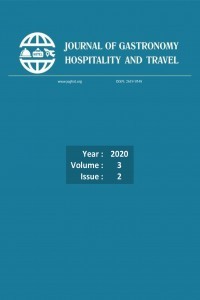FLAVORS OF LJUBLJANA CULINARY SCENE
FLAVORS OF LJUBLJANA CULINARY SCENE
Why tourists are paying a growing attention to food practices? Food is a significant cultural and natural identity marker (Berno and Fusté-Forné, 2019; Bessière and Tibère, 2013) and thus tourists seek to discover landscapes through food (Fusté-Forné and Berno, 2016; Hillel, Belhassen and Shani, 2013; Kim and Eves, 2012; Sidali, Kastenholz and Bianchi, 2015). Also, tourism organisations and businesses are increasingly using food and gastronomy as promotional and marketing tools (Cohen and Avieli, 2004; Du Rand and Heath, 2006; Okumus, Okumus and McKercher, 2007; Stanley and Stanley, 2015). Food, culinary and gastronomy tourism practices include a wide range of experiences, where eateries take a leading role (Levitt et al., 2019). While it is obvious that eating out is a compulsory consumption arena for travellers, there are other examples of food venues such as farms, markets or festivals, which also help in the boosting of food tourism at destinations (see, for example, Hall and Sharples, 2003; Timothy, 2016). Here, urban environments agglutinate the main tourist flows. This short article advocates that eateries in cities are a vital hook for tourists’ attraction and also a significant portion of their travel budgets. Furthermore, these food spaces are expected to convey a sense of authenticity of the place they are visiting (Goolaup and Mossberg, 2017; Jalis, Che and Markwell, 2014; Sims, 2009; Smith, 2015), providing a genuine experience.
___
- Berno, T. and Fusté-Forné, F. (2019). Imaginaries of cheese: revisiting narratives of local produce in the contemporary world. Annals of Leisure Research, 1-19 (ahead-of-print).
- Bessière, J. and Tibère, L. (2013). Traditional food and tourism: French tourist experience and food heritage in rural spaces. Journal of Science of Food and Agriculture, 93, 3420-3425.
- Cohen, E. and Avielli, N. (2004). Food in Tourism: Attraction and Impediment. Annals of Tourism Research, 31(4), 755-778.
- Du Rand, G.E. and Heath, E. (2006). Towards a Framework for Food Tourism as an Element of Destination Marketing. Current Issues in Tourism, 9(3), 206-234.
- Fusté-Forné, F., and Berno, T. (2016). Food Tourism in New Zealand: Canterbury’s Foodscapes. Journal of Gastronomy and Tourism, 2, 71-86.
- Fusté-Forné, F. (2017). Food Journalism: Building the discourse on the popularization of gastronomy in the twenty-first century. Barcelona: Universitat Ramon Llull.
- Goolaup, S. and Mossberg, L. (2017). Exploring the Concept of Extraordinary Related to Food Tourists’ Nature-based Experience. Scandinavian Journal of Hospitality and Tourism, 17 (1), 27-43.
- Hall, C.M. and Sharples, L. (2003). The consumption of experiences or the experience of consumption? An introduction to the tourism of taste. In: C.M. Hall, L. Sharples, R. Mitchell, N. Macionis and B.
- Cambourne (Eds.), Food tourism around the world. Development, management and markets (pp. 1-24). Oxford: Butterworth Heinemann.
- Hillel, D., Belhassen, Y. and Shani, A. (2013). What makes a gastronomic destination attractive? Evidence from the Israeli Negev. Tourism Management, 36, 200-209.
- Jalis, M.H., Che, D. and Markwell, K. (2014). Utilising local cuisine to market Malaysia as a tourist destination. Procedia - Social and Behavioral Sciences, 144, 102-110.
- Kim, Y.G. and Eves, A. (2012). Construction and validation of a scale to measure tourist motivation to consume local food. Tourism Management, 33(6), 1458-1467.
- Levitt, J.A., Zhang, P., DiPietro, R.B. and Meng, F. (2019). Food tourist segmentation: Attitude, behavioral intentions and travel planning behavior based on food involvement and motivation. International Journal of Hospitality and Tourism Administration, 20(2), 129-155.
- Ljubljana Tourism (2016). Taste Central Slovenia. Ljubljana: Ljubljana Tourism.
- Ljubljana Tourism (2019). Taste Ljubljana. Retrieved from: https://www.visitljubljana.com/en/visitors/thingsto-do/food-and-drink/article/taste-ljubljana/ Okumus, B., Okumus, F. and McKercher, B. (2007). Incorporating local and international cuisines in the marketing of tourism destinations: The cases of Hong Kong and Turkey. Tourism Management, 28, 253- 261.
- Price, L. (2017). Ana Ros puts Slovenia on the gastronomic map as The World’s Best Female Chef 2017.
- Retrieved from: https://www.theworlds50best.com/blog/News/ana-ros-puts-slovenia-on-thegastronomic-map-as-worlds-best-female-chef-2017.html
- Sidali, K.L., Kastenholz, E. and Bianchi, R. (2015). Food Tourism, Niche Markets and Products in Rural Tourism: Combining the Intimacy Model and the Experience Economy as a Rural Development Strategy. Journal of Sustainable Tourism, 23(8-9), 1179-1197.
- Sims, R. (2009). Food, place and authenticity: Local food and the sustainable tourism experience. Journal of Sustainable Tourism, 17(3), 321-336.
- Slovenian Tourist Board (2018). Taste Slovenia. Ljubljana: Ministry of Economic Development and Technology, Republic of Slovenia.
- Smith, S. (2015). A Sense of Place: Place, Culture and Tourism. Tourism Recreation Research, 40(2), 220-233.
- Somekh, B. and Lewin, C. (2005). Research Methods in the Social Sciences. London: SAGE Publications.
- SPIRIT Slovenija (2013). Taste Slovenia. Ljubljana: SPIRIT Slovenija.
- Stanley, J. and Stanley, L. (2015). Food Tourism: A Practical Marketing Guide. Wallingford: CABI Publishing.
- Timothy, D. (2016). Heritage cuisines: Traditions, identities and tourism. Abingdon: Routledge.
- ISSN: 2619-9548
- Başlangıç: 2018
- Yayıncı: Rahman TEMİZKAN
Sayıdaki Diğer Makaleler
FLAVORS OF LJUBLJANA CULINARY SCENE
THE ROLE OF COOPERATIVISM IN RURAL DEVELOPMENT: THE CASE OF BADEMLER NATURAL LIFE VILLAGE
Turgay BUCAK, Pınar GÜVEN, Roya RAHİMİ
Georgia ZOUNI, Evangelia BOGRI, İoanna GEORGAKI
AYŞE HANIMIN KARARI: TURİZM, ÇALIŞMA YAŞAMI VE SÜREÇSEL DRAMA
ASSESSMENT OF ECOLOGICAL POWER FOR LOCATING TOURIST VILLAGES
